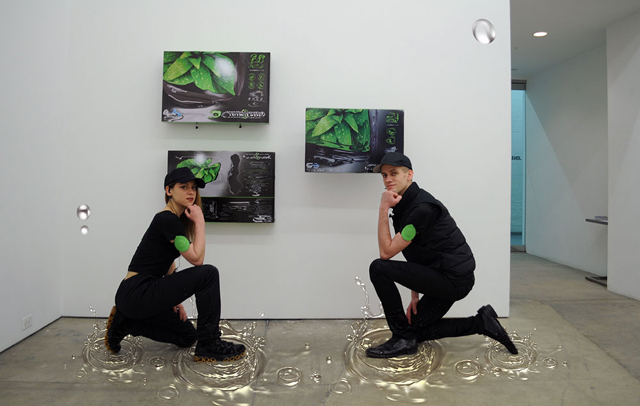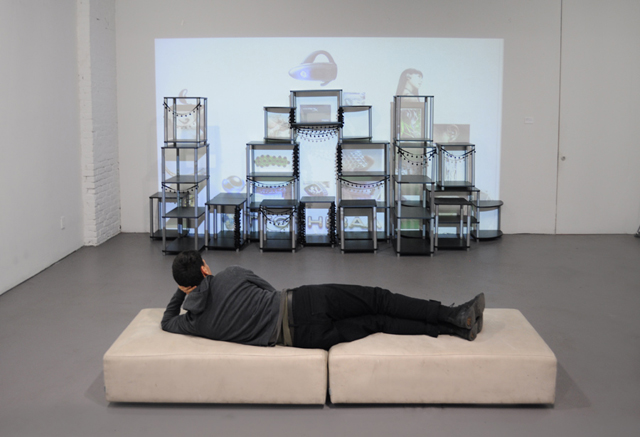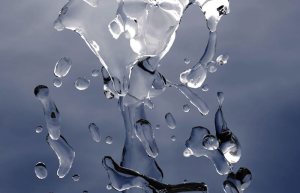Kari Altmann can be hard to pin down. Based in New York, born in Dallas, largely shaped in Baltimore and forever on the move, the semi-itinerant artist’s physical situation is as ungraspable as her art practice. Built around an awareness of the systemics of contemporary art and branding (because they can be interchangeable) Altmann’s work takes the existing tropes, modes and formats around image-sharing and data networks and repurposes them to reveal the embedded power structures and inequalities they often represent.
A Tibetan girl and a sheep carcass flanked by an iChat bubble and a universal WiFi symbol, a man muzzled by a mask wearing a SONY-branded t-shirt flipped by Photo Booth to read ‘YNOS’ –reblogged and reframed in her R-U-In?S tumblr –a glamour selfie of a girl so magnified in the Ttoshibaa window it becomes hard to make out. These are all images that take the familiar and reveal their inherent weirdness within a singular aesthetic of freakish hues and mutant textures, appropriated and reconditioned within a nebulous landscape shifting from ‘online’ to ‘offline’ without discrimination.
“Art and information already travel as brands today,” Altmann tells me via Skype, with only text from a chat box and a thumbnail headshot to go on in forming an impression of her as a person. In refusing a spoken interview and insisting on generatively constructing a “document” rather than an interview per se, conversation with the artist becomes a fragmented and shape-shifting dialogue across media, focusing on getting her point across as accurately as possible.

At first it strikes me as odd, this concentration on wanting to so control the outcome of our back-and-forth, especially given the ambiguous nature of Altmann’s work –where the distinction between her art and the branding it purports to pervert can be hazy at best. But then, that’s kind of the point. Zeroing in on the subtle strangeness of media-at-large and the misleading pretension to equal access that networked culture reproduces, Altmann’s work applies to certain reference points founded on a complex network of signifiers often missed but still somehow felt within a language and a landscape of images. They’re as familiar as they are completely alien.
You said you wanted to talk more about objecthood rather than brands but you also say that ‘maybe it’s a similar phenomenon’. Do you think there’s a blurred distinction?
KA: A brand is just a format, an object is a format. The point of my practice is that formats are fluid, that an artwork can now live as something beyond that, and constantly shift between mediums and contexts. This is, to me, how the internet has added options to what an artwork can be, what an image can be, and how it can move and display itself. I produce all kinds of things but my favorite projects are creating networks of cultural technology. All my content gets put through a process like that in the end.
Do you feel the pressure of putting your work into new formats?
KA: I’m always experimenting. There’s been a lot of object pressure for artists who are embracing newer ideas of production, so that gallery shows can be achieved more easily. This has either bitten off more than it can chew in the constraints of its display, or resulted in a lot of predictable, sellable printouts. There has to be more willingness to re-think the production, but resources and equipment are scarce. I’m working on that when I can, but not every exhibition is an opportunity for it. A lot of shows are more like rapid content-sharing platforms. The money and audience structures are more and more varied –the labor and viewing structures, too. What you see in a gallery is not always the ‘whole’ work.
The whole set of content together, in various platforms over time, is now the larger cohesive artwork for a lot of my practice, since I’m authoring fields of visual culture. These are the kinds of meta image structures we now know how to read, the ones we enjoy looking at and hunting in.
I’m into the idea of ‘soft brands’, ‘abstract brands’… to me that’s a good environment for art. Whether it references a pre-existing powerful brand or not is not really important, the idea is that it’s all up for grabs.

But in saying something is up for grabs, it implies there’s a limited distribution; there’s an embedded power structure there.
KA: There is a pre-existing power structure in any material you’re going to use. Some are bigger than you and some aren’t.
Then, in terms of taking these ‘brands’, so to speak, that have certain representations, and re-purposing them, you’re shifting them to serve another individual need but not necessarily restructuring (or deconstructing) the unequal nature of what it is at its core.
KA: I think I am restructuring them, but with a knowledge that I can’t control every impression they make beyond my work. I can corral them into my own specialized contexts and add my definition to their disambiguation as a territorial act, recognizing that while they may be familiar, they’re still foreign agents. I can treat them like a social network which I have a user account on, and view them from my lens. That’s an important distinction between work like mine and others which just re-blog the logos. Any time I use brand tactics, it relates to a different system of images and ideas, a different meme which I’ve created.
I don’t have a direct relationship with any of these companies, for instance, so their language always feels a bit far away, a bit abstract and soft branded already. It’s about assuming the impressions they leave as a part of the cultural fantasy landscape and being honest about it, collaborating with it to produce new narratives. Things aren’t as simple as ‘inside’ or ‘outside’ the larger structures of what pop culture and corporate culture are. Instead it’s about finding forms of work that can survive in a blended climate without sacrificing the difference, without being aggregated by a different intent. Every image gets a deeper read, gets multiple breakdowns, as it flows through different environments. Context is key.
In America brands are everywhere, and the language is more and more evocative and territorial… more and more alien. Yet they’re somehow also completely banal due to oversaturation. There’s this weight of them hanging in the atmosphere. They can reveal themselves in uncanny lures or subliminal, ethereal sensations, but there is always a stress, a friction that comes with it. This sensation, this texture, is what draws me in, not just in brands but in all kinds of content –this feeling of heightened biological tactics.

Do you then think it’s problematic when art that originally repurposes has “something to do” with these companies, eg is funded by them?
KA: Sometimes yes, and I’ve talked about this before. For instance when LOGO magazine started they tried to get Tumblr artists in this R-U-In?S genre to make “artvertorials” for brands for money. Using the surface lures of this trend to then attract corporate sponsorship from said brands. To me that was missing the point entirely, because it was attaching those signifiers to the wrong set of images, so I turned them down. The only way that would work would be if the corporate brand didn’t have the final say, didn’t have creative control… but of course they have a bunch of requirements for how something must be presented and sold through imaging that are not always a part of how those terms and icons get used culturally.
A fair trade between those kind of entities is tricky to reach at this point… ultimately you have to find a way to game every request you get. R-U-In?S was aware of this problematic context.
A major issue for me is this ‘awareness’ that also becomes a crutch and an excuse for collusion.
KA: I’m not exactly sure what you’re getting at. Like accepting the environment as it is? Participating in corporate sponsorship as part of the performance?
Yes. This ultra-cynical self-reflexivity that kind of leads to stasis.
KA: Well sometimes it works, sometimes it doesn’t. Sometimes the artist is driving and sometimes it’s clear they aren’t. I think the people who fall for it in the worst way are the ones who didn’t get it in the first place, or who maybe don’t understand the contextual subtleties at play because they haven’t experienced the longterm outcome. Or maybe they just don’t know about the alternatives.
The more you tap that culture and that vitality, the more cautious you need to be about ethics and representation, to keep it alive. Product pressure is also rampant. This is something I talk a lot about with other people who have done things in ‘scenes’–how much someone with a lack of communal awareness can damage something very quickly.
So are you saying if you’re within a scene you have a greater understanding?
KA: I think if you’ve ever had to build your own microculture among your peers with its own economy, you have a different understanding of what a ‘scene’ is, maybe. Sometimes that is a class divide, a lifestyle divide, or just a matter of experience. The internet allows you to open up a cultural system to so many people, which is awesome, but not all of them are going to understand exactly where you’re coming from, and they’re not always going to participate in a way that sustains it. Activating certain ideas or images into a culture is a worthy initial goal… eventually those impressions will sink deeper… but online there can be a lot of hazy assumptions.

Do you think though, that there’s an end point? I’ve often felt like there’s a line that anyone can cross. I have some specific examples of art and artists in my mind that I think can no longer make that claim, but maybe once did and could.
KA: There is a chain of production awarenesses that you can either knowingly comment on or ignore. In some cases the line between what’s a performative commentary and what’s not gets blurred. Again, sometimes things aren’t so simple as inside or outside, but have to be both. The artist has to be really in control of those decisions, of that performance and context, for it to work well. It depends on what’s a fair trade to you, and what your ethics are. Unfortunately, that also has ramifications for anything else being tagged into the same pool as your work, and you always have those people jumping in who are just replicating the tags, not the source of them.
That’s the problem, isn’t it? Deactivating resistance by discrediting it.
KA: Well you can’t control mistranslations though. You can just re-aggregate them, put them back in your own context.
How would you do that?
KA: Just keep going, basically. Take the lead. **
Kari Altmann is a New York-based artist.
Header image: Kari Altmann, ‘Ttoshibaa’, 2009-Ongoing. Still image. Image courtesy the artist.














